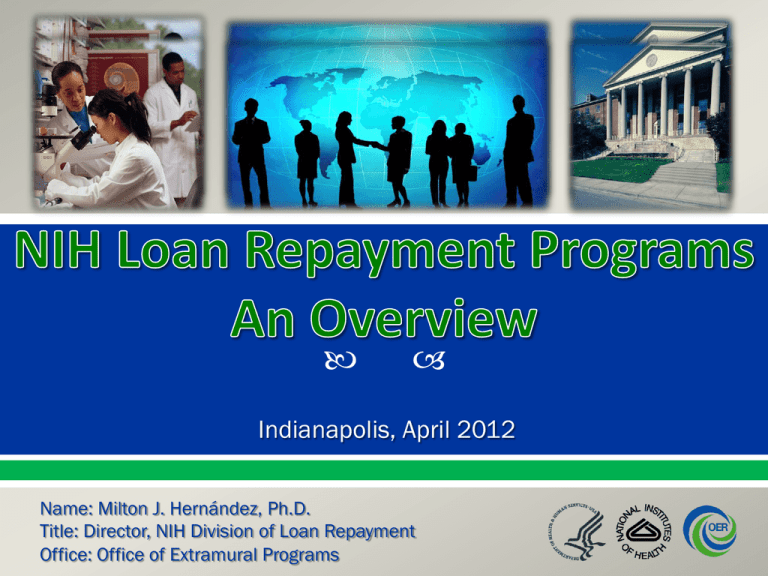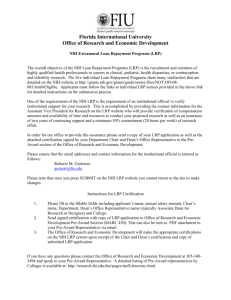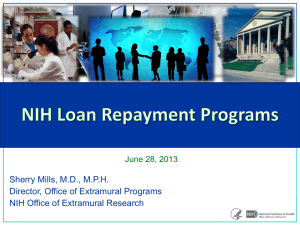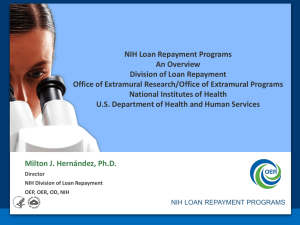NIH Loan Repayment Programs
advertisement

Indianapolis, April 2012 Name: Milton J. Hernández, Ph.D. Title: Director, NIH Division of Loan Repayment Office: Office of Extramural Programs Summary •Up to $35,000 per year in educational loan repayment depending on debt level •Coverage of most Federal taxes resulting from the NIH LRP •2 Year initial contracts with 1 or 2 year competitive renewal contracts •NIH Institutes and Centers fund approximately 1,600 researchers each year •Applicant success rate is 50 percent 2 Extramural Programs Eligibility 1. 2. 3. 4. • Doctoral degree (M.D., Ph.D. or equivalent) o EXCEPTION = Contraception & Infertility Research LRP • Research funded by a domestic nonprofit, university or government organization • Educational loan debt equal to at least 20 percent of your annual salary • Conduct qualifying research for at least 20 hours/week • U.S. citizen, U.S. national or permanent resident Clinical Research Pediatric Research Health Disparities Research Contraception and Infertility Research 5. Clinical Research for Individuals from Disadvantaged Backgrounds 3 NIH will repay: • Educational loans guaranteed by the U.S. Government • Educational loans from accredited U.S. academic institutions and commercial lenders NIH will not repay: • Non-education loans (e.g., home equity loans) • Loans consolidated with another individual (e.g., spouse or child) • PLUS loans to parents EXCEPTION: PLUS loans disbursed to graduate and professional students on or after July 1, 2006, qualify for LRP repayment • Loans that have been converted to a service obligation • Delinquent loans, loans in default, or loans not current in repayment 4 Individuals are not eligible for the NIH LRPs if they: • Have a Federal judgment lien against their property arising from a Federal debt • Are a full-time Federal government employee or VA Fellow • Owe an obligation of health professional service to the Federal government, a state, or other entity, unless deferrals are granted for the length of their LRP service obligation o NRSA T32, T90 and F32 awardees are eligible. NIH grants a deferral of the NRSA service obligation. 5 Clinical Research Patient-oriented clinical research conducted with human subjects, or research on the causes and consequences of disease in human populations involving material of human origin (such as tissue specimens and cognitive phenomena) for which an investigator or colleague directly interacts with human subjects in an outpatient or inpatient setting to clarify a problem in human physiology, pathophysiology or disease, or epidemiologic or behavioral studies, outcomes research or health services research, or developing new technologies, therapeutic interventions, or clinical trials. Clinical Research for Individuals from Disadvantaged Backgrounds See above definition for Clinical Research. A researcher from a family with an annual income below an established level is considered to be from a “disadvantaged background.” Current financial need alone is not sufficient to qualify for this program. 6 Pediatric Research Research that is directly related to diseases, disorders, and other conditions in children, including pediatric pharmacology. Contraception and Infertility Research Research whose long-range objective is to evaluate, treat or ameliorate conditions which result in the failure of couples to either conceive or bear young; contraception development is defined as research whose ultimate goal is to provide new or improved methods of preventing pregnancy. 7 Health Disparities Research Basic, clinical, and behavioral research on health conditions including diseases, disorders, and such other conditions, including the causes of such disparities and methods to prevent, diagnose, and treat the diseases associated with health disparities, that are unique to, more serious, or more prevalent in health disparities populations (either individual members or communities of such populations). A "health disparities population" is defined as a population for which, as determined by the NIMHD Director in consultation with the Director of the Agency for Healthcare Research and Quality, there is a significant disparity in the overall rate of disease incidence, prevalence, morbidity, mortality, or survival rates in the population as compared to the health status of the general population. 8 9 Panels evaluate each applicant’s potential to succeed in a research career by rating: 1. Applicant’s previous training and research experience 2. Applicant’s commitment to a research career 3. Current research environment 4. Research progress—for Renewal applications only 10 The LRP application is divided into three sections: 1. 2. 3. Personal Information This includes contact and educational background about the applicant, funding sources information, a personal statement about career goals, certifications (required signatures), and verification of citizenship status. Research This step includes identification of your research supervisor, if applicable, and a description of your proposed research, your list of colleagues who will recommend you, and the institutional official who can provide salary information and confirm your institutional support. As each form is submitted, NIH sends e-mail requests to either your research supervisor, recommender, or institutional contacts and they are asked to respond online. Loans This section is only for new applicants. You will need to provide lender and servicer name and address, loan number, disbursement date, total loan, current balance, monthly payment, interest rate and type and status (in repayment/deferment/forbearance). 11 These tips will help you strengthen your application. 1. Know the funding priorities of your NIH Institute or Center. 2. Effectively demonstrate your qualifications and commitment to research. 3. Describe resources and support thoroughly. 4. Write a strong research plan. 5. Provide strong letters of recommendation. To download this complete document, visit http://www.lrp.nih.gov/pdf/0310_1_application_tips.pdf 12 The following conditions often weaken an applicant’s competitiveness. 1. Weak or lukewarm recommendation letters 2. Questionable research commitment 3. Mediocre research plan 4. Rushed application 5. Inadequate research environment 6. Slim publication record 13 14 September 1 – November 15: Application Cycle November 15, 8 p.m. ET: Application Deadline December 1: Colleague Deadline December 31: Contract and Online Certification & Citizenship Forms Deadline February – May: Application Peer Review May: Initial Selection May – July: Financial Vetting July 1: Contract Start Date Mid-July: Final Funding Decisions and Recipient Notification August – September: Contract Signing October: First Payment to Lender 15 LRP Information Center Open each weekday from 9 a.m. to 5 p.m. ET (866) 849-4047 or LRP@nih.gov Webinar: Overview of Loan Repayment Programs http://go.usa.gov/aHx LRP Web site: http://www.lrp.nih.gov Twitter: @NIH_LRP Facebook: http://www.facebook.com/nihlrp 16











